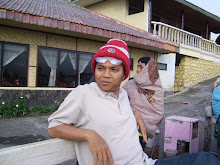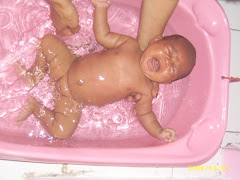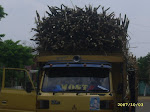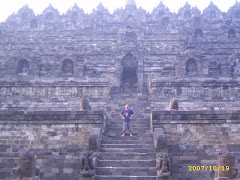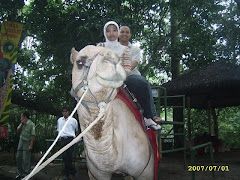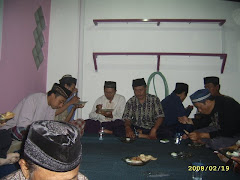 Oleh : Mangku Purnomo
Oleh : Mangku Purnomo
1. Nature of Environmental Changes: Poor People Perspective
Climate change will influences all of countries where people are highly dependent on natural resources for their livelihoods. Resources degradation in rural area also was caused by logging, mining, and tourism. Green revolution as a main policy to increase agricultural production has brought environmental problems such as the excessive and inappropriate use of agrochemicals pollutes waterways, poisons people, and upsets ecosystems (World Bank Report, 2008:180). In the long term, process of agriculture activities will increase the variability of climate change because of it contribution in increasing carbon deposit in the climate system. According to the prediction of four methods (HadCM3, GISS, UKMO, and GFDL), climate change will decrease 5% of Indonesian rate of yield in 2080. Furthermore, Indonesian agricultural capacity will decrease -17.9% without fertilizer and -5% with fertilizer (Cline 2007:77) [1]. In upland areas of
The most Devastating impact of climate change in
On the local level, appearance of climate change and it impact had been understood in certain form. It had been depend on the local culture that people give meaning to their environment. That construction had been often different with the formal inquiry because it had been constructed by local community corresponding their experience and local knowledge. Every community has the specific knowledge and practice to shape their lives in order to survive in the variability environment. It is a cumulative body of knowledge, practice and belief, involving by adaptive processes and handed through down by cultural transmission, about the relationship of living beings (including humans) with one another and environment (BERKES, 2008:10)[4].
Local knowledge appears in certain areas with specific form but it also have the common values and features that are (1) Cooperation, (2) Family bonding and cross-generational communication including links with ancestor, (3) Concern for well-being of the future generation, (4) local scale, self sufficiency, and reliance on locally available natural resources, (5) right to land, territories and resources which tend to be collective and inalienable rather than individual and alienable, and (6) restraint in resources exploitation and respect for nature especially for sacred sites (POSEY and DUTFIELD, 1996 in ELLEN ET. AL., 2000:36)[5].
On the practical level, there are many forms of local knowledge presented by local communities to shape the climate vulnerabilities[6]. They are depend on the kind of climate vulnerabilities. For instant, in outer Indonesia, Kalimantan Island, when the El Nino of 1997 and the 2002 drought was occurred, the farmer can survive with their local knowledge through selling the rubber latex though it had low prices. Increasing prices of the others plantation plant such as palm, pepper, coffee, cinnamon, and cocoa did not enhance local farmer to cut the rubber trees though its ware not efficient. When the Drought and El Nino occurred, they could provide cash income from that commodity (PURI, 2007:46)[7].
2. Nature of Poverty in Rural Area: Poor People Perspective
Poverty is a classic question for the scholar but still important because of it emergence in all societies around the world, not only in the developing or under developing countries but also in the develop countries. Recently, in the post modernism period in which prosperity of existence of human being increasing dramatically, poverty still important because of the rapid increasing of poverty in the recent social live in face of environment and political changes. In the same time, debate on poverty also spread in the many subject of studies.
In the past, poverty was measured in terms of the share of the population with incomes below one poverty line or another. The definition of poverty needs to be broadened beyond the traditional expenditure based measures to include access to basic services such as health, education, justice and infrastructure. Not only physical indicator, poverty also is laid to extent of opportunities for people to participate in social and political decision-making. It is needed to capture poverty more rich and precise in order to get knowledge for subsequence studies and policy planning. CHAMBERS (1989, 1992) suggest researcher to combine both material and non-material dimensions of poverty in the strategy of analysis of poverty. Poverty analysis also includes the non-material dimension such as a set of interlocking factors, including physical weakness, social isolation, vulnerability and powerlessness.
Poverty phenomenon recently had been accepted as the consequences of interactional process in society in which persons or groups are lack to access economy, political and social obligation from the community. One of the innovation concepts is social exclusion. Social exclusion may therefore be understood as an accumulation of confluent processes with successive rupture arising from the hearth of economy, politic, and society, which gradually distances and places person, groups, communities and territories in position of inferiority in relation to centres of powers, resources, and prevailing values (ESTIVILL, 2003:19)[8].
As a structural process, poverty had been influenced by some external factor created and perpetuated rural poverty is that: (1) political instability and civil strife; (2) systemic discrimination on the basis of gender, race, ethnicity, religion, or caste; (3) ill-defined property rights or unfair enforcement of rights to agricultural land and other natural resources; (4) high concentration of land ownership and asymmetrical tenancy arrangements; (5) corrupt politicians and rent-seeking public bureaucracies; (6) economic policies that discriminate against or exclude the rural poor from the development process and accentuate the effects of other poverty-creating processes; (7) large and rapidly growing families with high dependency ratios; (8) market imperfections owing to high concentration of land and other assets and distortion of public policies; and (9) external shocks owing to changes in the state of nature (for example, climatic changes) and conditions in the international economy[9].
In the local level in particularly household level in rural area of
In the modernization period after the independence, impoverishing was continued with different ways. For instant, increasing of numbers of farmer in the KULON PROGO Regency will raise the numbers of poor rural households. Large scale of land ownership was getting smaller that influenced by inheritance culture of Javanese that distribute land to each descent. Therefore, in the long term, the number of household member plays a significant role to decrease land size ownership in each household (ZAMAL, 2008). Poor farmers also can not access non farm economy because of their lack of capital and human resources.
Nature of poverty in rural area is created by social structure through maintenance the cultural norm that shapes the traditional heritage mechanism though the changes of rural economy demand more wide land to reach the economic scale. It is coherent with GEERZT founding in which a heritage system in Java plays an important factor in narrowing land occupation. According to these founding, scarcity resources was caused not only by environment changes that ensure the degradation of land but also the nature of social system that exclusion the poor farmers from the mainstream of local economy.
3. Local People’s Mitigation and Risk Perception
According to UN/ISDR (2004, in THYWISSEN, 2006) mitigation is the Structural and non-structural measures undertaken to limit the adverse impact of natural hazards, environmental degradation, and technological hazards. Adoption and implementation standards and codes to protect the infrastructures, people etc., from extreme event base on an analysis of probabilities of event and the cost of implementation. Mitigation is the systematic actions to reduce the impact of environment changes including developing the indicator of risk, measuring the effect of changes if occurred, developing long-term risk reduction measures, improving technologies to prevent its such as constructing stronger buildings, evacuation method, manual procedure to avoid the disaster hazard. Mitigation includes both the planning and implementation of measures to reduce the risks associated with known natural and human-made hazards, and the process of planning for effective response to disasters which do occur.
On the local level, recently in light with the rapid increasing of environmental changes, people work in complex and uncertain environments. Naturally, they can develop mitigation to the environmental practices which eventually form the overall body of local knowledge. Mitigation and local knowledge adaptation are two of many kind of local knowledge employed by scientist and planner to get the adequate adaptation system in the vulnerability world. Local people in particular their traditional ecological knowledge related with the environmental changes have notice for the environment scientist because of it role in the conjunction of people adaptation in the environmental changes. In the planning process, growing recognition of the limits of conventional science in solving ecological problems of increasing complexity and magnitude has also resulted in calls for the incorporation of traditional ecological knowledge and practices into resource management and development (Wolfe et al., 1992)[11]. For instant, in the beginning of disaster, when the formal system offered by NGO or government has not come, the local knowledge can lead people to face and respond to the situation. Mitigation means taking actions to reduce the effects of a hazard before it occurs. The term mitigation applies to a wide range of activities and protection measures that might be instigated, from the physical, like constructing stronger buildings, to the procedural, like standard techniques for incorporating hazard assessment in land-use planning.
In this research, I will explore three main aspects of local knowledge related with the mitigations process that are: (1) classification and identification of natural phenomena, (2) concepts of cause and effect, and (3) concepts of natural resource processes. Firstly, related with classification and identification, local people have their own knowledge to classify and identify the natural phenomenon such as kind of rainfall, wind, cloud, dew, land slide, flooding, and so on articulated in local term. The categories of that term often different with the scientist because of the different point of view and methodology employed to construct the definition about environment phenomenon. If scientists tend to explore with the material dimension, local people with their traditional view that developed and spread from generation to generation. In this research, I will compare local knowledge and scientist point of view in order to get more clear comprehension.
Secondly, related with the concept of cause and effect of environmental changes, local people often connect the cause of the environmental changes with their world-view in spite of the fact that it can observe with the material view. King et all, (2008:390) cosmology view of Maori tribal plays the important role in the construction process of their knowledge about environmental changes though there are no single cosmological view among MĀORI. Cosmology in the certain level shapes the meaning of environment phenomenon and the relationship between human and environment.
The third one, to understand the concept of natural resources process, local people often relate the process of environmental changes with the natural power as a given phenomenon coming from outside community. Nature is angry because of the humankind in the wrong track. In TNBTS for instant, SUTARTO (2008) the eruption BROMO mountain was understood by TNGEERESE as a impact of un-ideal human behaviour in which they did not obey the traditional moral wisdom such as people become stingy, arrogant, gluttonous as a sign of unhealthy community (JAMAN EDAN). Flooding for instant, despite they know damaging forest and erosion are the main causes, community sin (DOSA MASYARAKAT) is the main cause of damaging. Individual who cut the forest or make damaging in the Javanese believe only an actor as a victim of unhealthy community. As a result, to explain the process of environmental changes, local people tend to related it with the outside cause and neglected the material causes. Local knowledge about mitigation further leads the people to perceive and calculate the impact of environmental changes in their live.
W., J., AMANN (2004:5) defines risk as a produce of (1) the frequency or probability of a “cathastrophic” event/disaster, (2) the scale of damage, as measured by number of people and the value of the material damage caused at the moment of the actual causal event and accounting for the susceptibility of the affected people and asset in which the value of the damage has an ecological, an economic, or a social dimension. According to this definition, risk is potential consequences (uncertain condition) of an event or activities on the human being, building, infrastructure, and other asset. Although, it definition base on the experts calculation, every community has own knowledge to understand risk. Comprehension of risk has closed relationship with the people mode of adaptation[13].
In
Michael R. Dove, (2008) found that villagers living on Merapi have developed a system of religious belief, and a system of agro-ecological practices, that ‘domesticates’ the volcanic hazard. Based on that point of view, the villagers view eruptions as agents of change, often change for the good. Perception of risk merely can not explain the mode of people behaviour in the changing environment. As a result, making direct relationship between perception and human adaptation especially in Javanese culture will make faulty[15]. For this reason, it is important to understand the local perception of risk with the cultural aspect that shape local people behaviour.
Gaillard (2008) work in
Others factor that influence the local people behaviour is the differences intention of the local knowledge among them. In fact, Knowledge and access to knowledge are not spread evenly through a community or between communities. Differences of people objectives, interests, perceptions, beliefs and access to information and resources influence their knowledge to address the environmental changes. Differences in social status can affect perceptions, access to knowledge and, crucially, the importance and credibility attached to what someone knows. As a result, the marginal group in society is often has a poor knowledge compare with the elite group. Indeed, their social economic status decreases their capacity to address the environmental changes. Meanwhile, in the adaptation process, capability is the main factor determining human ability to address uncertain condition.
4. Local People’s Perception of Vulnerability
The term ‘vulnerability’ is used in many different ways by various scholarly communities. The resulting disagreement about the appropriate definition of vulnerability is a frequent cause for misunderstanding in interdisciplinary research on climate change and a challenge for attempts to develop formal models of vulnerability[17]. Wisner et al (2004) noted that vulnerability is the characteristics of the person or group and their situation influenced their capacity to anticipate, cope with resist and recover from the impact of natural hazards (an extreme natural event or process). It involves combination of factor that determines the degree to which someone life’s, livelihood, poverty and others asset are put at risk by discrete and identifiable event (or series or “cascade” or such event) in nature and society[18].
IPCC define vulnerability as the degree to which a system is susceptible to, or unable to cope with, adverse effects of climate change, including climate variability and extremes. Vulnerability is a function of the character, magnitude, and rate of climate variation to which a system is exposed, its sensitivity, and its adaptive capacity (IPCC, 2001: 995)[19]. CUTTER ET ALL., (2003: 246-249) divided vulnerability on two dimension both physical refer to inappropriate material environment to support human being and the social refer to inability of human social economic aspect. The last one, CUTTER ET AL., collected several concept socioeconomic status (income, political power, prestige), gender, race and ethnicity, age, commercial and industrial development, employment loss, rural/urban, residential property, infrastructure and lifelines, renters, occupation, family structure, education, population growth, medical services, social dependence, special needs populations.
ROGER FEW, (2003:50-51) noted that vulnerability not only a natural factor such as environmental changes but it also a social product[20]. Formerly, BLAIKIE ET AL. (1994) introduced the close relationship between vulnerability with the political and economic factor[21]. How to fine the real vulnerability in the community? T. Cannon, (2006:41-47) identify six component of vulnerability that are (1) Livelihood strength and resilience, (2) initial well being or base line of status, (3) self protection, (4) social protection, (5) government, civic society and institutional frame work[22]. Firstly, initial well being or base line of status consist a nutrition status, physical health, mental health, and security and identity. These components were determined by livelihood strength and resilience and security and freedom from stresses such as conflict and intra household differences.
Secondly, livelihood strength and resilience have five sub component that are: (1) financial asset (or capital), (2) physical asset, (3) human capital, (4) natural capital, (5) resilience of linkages between people and their employment, and (6) resilience of linkages people’s asset and their income streams. Than, these sub components were determined by their liability to damage in a given type of hazard, amount and quality of asset (capital) owned and accessible to person especially to enable productive and income generating and or self provisioning (subsistence farming) activities, dependent on their employment activities and other income generating opportunities when lacking productive asset and their risk disruption by hazard event.
Thirdly, self protection consist three main sub-components that are (1) adequate income, (2) availability of suitable material and technical knowledge, and construction skill, and (3) willingness to take necessary steps. These sub-components were determined by adequate livelihood to provide finances, access to relevant technology and construction techniques, motivation, and risk awareness.
Fourth, social protection consist all of components in the self protection plus technical regulation or technical intervention by higher levels. That sub-component were determined by an adequate revenues for the local or national government to do what is needed, a political will at local and national government level; this provides the motivation to implement building codes, mitigation measures, protection of schools and infrastructure, etc., and availability of relevant technical knowledge and ability to implement. It is also including level of scientific knowledge such as characteristic of technical practices (elitist?), quality and robustness of insurance system, type of science and engineering used by government and dominant group.
Fifth, government, civic society and institutional frame work affects the distribution of risk because they are dispose the allocation of different levels of vulnerability among groups of people. Government has also power to manage a country’s economic and social resources for development. The exercise of power in the resources management sphere naturally involves component of society that are the private sector, civil society and international organizations. It means, to explain the vulnerability related with the government and civic society actor must be laid at the context of exercise power in the resources management system[23].
According to the explanation above, vulnerability is therefore a socially constructed phenomenon influenced by institutional and economic dynamics. The challenges for vulnerability research are to develop robust and credible measures, to incorporate diverse methods that include perceptions of risk and vulnerability, and to incorporate governance research on the mechanisms that mediate vulnerability and promote adaptive action and resilience[24]. In this research, I will employ vulnerability concept that be applied consistently to studies of vulnerability and adaptation in a wide range of contexts by researchers with different backgrounds, concerned with the impacts of and responses to climate variability and change within human systems. In this term, vulnerability represents the interface between exposure to the physical threats to human well-being and the capacity of people and communities to cope with those threats. Therefore, in this research I am focus on local people perspective on environmental changes and its impact on their life as a guide to improve adaptation initiatives in the household level.
5. Local People’s Adaptation of Vulnerability
The concept of adaptation has been adopted in several fields including climate impact assessment and policy development, risk management, and natural hazards research (Smith et all, 1999). In the environmental context,
Adaptation as a concept has many dimension that are (1) strategies among choice, (2) capabilities both individual and system, (3) encompassing area from local to global, (4) covering level from individual to institutional. Firstly, the individual and institutional selected certain activities to alter the stressor both from the outside and outside social system in order to diminish the risk in their well being. Secondly, capabilities shape the success of strategies and it depend on their capabilities to make use opportunities from the society and their self. NELSON ET., AL., (2007) define adaptive capacity as the preconditions necessary to enable adaptation, including social and physical elements, and the ability to mobilize these elements YOHE and TOL, (2001) describes the adaptive capacity as a characteristics of an individual, household or population group which enable it to alter and structurally reorganize its activities to diminish present threats to survival while enhancing its ability to address new risks[26]. Thirdly, the adaptation is not only in the local level such as community and household vulnerability in the every day live but it also including national, regional, continental, and global level. Finally, an individual is refer to the dynamic of person to alter the stressor involving the psychological process, belief, and attitude while an institutional is refer to set of norm, custom, and value in the society which promote the strategies conducted by society individual, household, group, or other social unit. According to the NELSON ET., AL., (2007) work, in this perspective an Actor-based analysis looks at the process of negotiation and decisions, and the systems based analysis examines the implications of these processes on the rest of the system. There are interconnectivities between actor as an active agent to influence the system and vice versa.
SMITH and SKINERS (2002:93-94) introduced the characteristics of adaptation that are: (1) intent and purposefulness, (2) timing and duration, (3) scale and responsibility, and (4) form. Intent and purposefulness means that adaptation was conducted by people have spontaneously or autonomously characteristic in the management undertaken to address a climate-related risks. Base on the timing and duration of adaptation, they differentiate on the three characteristics that are anticipatory (proactive), concurrent (during), or responsive (reactive). Scale and responsibility refer to at which adaptations occur (example for agriculture are plant, plot, field, farm, region and nation) and the agents who responsible for these adaptation (farmers, private industries, and public agencies). Finally, adaptation has many forms depend on the agent, scale, and the variety of the strategies chosen by agent[27].
As a process, adaptation has an adaptation cycle through space and time which draws the sequence event including several action and reason way and how people adapt to same stressor. E.E. WHEATON and D.C. MACIVER (1999:218) introduced five questions as a sequence event in the adaptation cycle that are; (1) what do they adapt to and why (adaptation for what), (2) how do they are adapt? (The processes of adaptation), (3) what impacts result (ecosystem, socioeconomic, and integrated system)? (4) how well they do adapt? (Evaluation), and (5) who and what system adapt? (Characteristics, goals, and values)[28].
6. Next Adaptation?
In light with cycle of adaptation above, Smith et al, (2001) introduced clearer frame work to analysis the process of adaptation in the environmental changes. There are four question to describe adaptation that are (1) adaptation to what? (Climate related stimuli-phenomena and time/space scale), (2) who or what adapts? (system-definition and characteristics), (3) how does adaptation occur? (Type process and out come), and (4) how good is the adaptation? (Evaluation criteria and principle)[29].

Figure 1 Adaptation to climate change and variability (SMIT ET AL., 2000)
Success of people adaptation to vulnerability was shaped by their capacity to address the uncertain condition. According to (SCHMUCK, 2000, in TRONDHEIM, 2002), capacity encompasses potential of a given civil society (1) To determine who may use coercive power, and its capacity to restrict such use, (2) To allocate resources efficiently and distribute resources equitably, (3) To mediate and resolve disputes and conflicts between individual members as well as among groups, (3) To identify problems and issues, develop solutions to those problems, and implement the solutions, (4) To instigate and facilitate processes in which individuals and groups with diverse and competing interests excel as a result of engaging in competition; and, society’s capacity to instigate and facilitate processes in which individuals and groups with common interests collaborate to reach a common goal or goals[30]. According to the explanation above, can Indonesian rural people mitigate and adapt to those worst conditions?
[1] William R. Cline, 2007, Global Warming and Agriculture: Impact Estimates by Country, (geophysical fluid dynamics laboratory, Goddard institute for space studies, UK Hadley centre for climate prediction and research coupled model 3, UK Meterological office)
[2] BENISTON, 1994, Mountain Environments in Changing Climates, Routledge, 1994
[3] David Brian Dewitt,
[4] Fikret Berkes , 2008, Sacred Ecology: Traditional Ecological Knowledge and Resource Management, Routledge.
[5] Roy Ellen, Peter Parkes, Alan Bicker, 2000, Indigenous Environmental Knowledge and Its Transformations: Critical Anthropological Perspectives, Routledge
[6] R. F. Ellen, 2007, Modern Crises and Traditional Strategies: Local Ecological Knowledge in
[7] Rajindara K. Puri, 2007, Respon to medium term stability in climate; El Nino, drought, and copping mechanism of foragers and farmers in borneo, in R. F. Ellen, 2007, Modern Crises and Traditional Strategies: Local Ecological Knowledge in Island Southeast Asia, Berghahn Books
[8] Jordi Estivill, 2003, Concepts and Strategies for Combating Social Exclusion, International Labour Organisation
[9] Mahmood Hasan Khan, 2001, Rural Poverty in Developing Countries Implications for Public Policy, ECONOMIC ISSUES NO. 26, International Monetary Fund
[10] Benjamin White, 1973, Demand for Labour and Population Growth in Colonial Java, Human Ecology, VoL 1, No. 3, 1973
[11] WOLFE, J., BECHARD, C., CIZEK, P., and COLE, D., 1992, Indigenous and Western Knowledge and Resource Management Systems,
[12] D. N. T. King & A. Skipper &W. B. Tawhai, 2008, Māori environmental knowledge of local weather and climate change in Aotearoa – New Zealand, Climatic Change (2008) 90:385–409
[13] W., J., AMANN, 2004, Risk concept, integral Risk management, and risk governace, 2004, in Walter J. Ammann, Stefanie Dannenmann, Laurent Vulliet, Risk 21 - Coping with Risks Due to Natural Hazards in the 21st Century: Proceedings of the Risk21 Workshop, Monte Verita,
[14] Franck Lavignea, Benjamin De Coster, Nancy Juvin, François Flohic, Jean-Christophe Gaillard, Pauline Texier, Julie Morin and Junun Sartohadi, 2008, People's behaviour in the face of volcanic hazards: Perspectives from Javanese communities, Indonesia, Journal of Volcanology and Geothermal Research, Volume 172, Issues 3-4, 20 May 2008, Pages 273-287
[15] Michael R. Dove, Perception of volcanic eruption as agent of change on Merapi volcano, Central Java, Journal of Volcanology and Geothermal Research Volume 172, Issues 3-4, 20 May 2008, Pages 329-337
[16] Jean-Christophe Gaillard (2008), Alternative paradigms of volcanic risk perception: The case of Mt. Pinatubo in the Philippines, Journal of Volcanology and Geothermal Research
Volume 172, Issues 3-4, 20 May 2008, Pages 315-328
Volcanic risk perception and beyond
[17] Hans-Martin Füssel, 2007, Vulnerability: A generally applicable conceptual framework for climate change research, Global Environmental Change Volume 17, Issue 2, May 2007, Pages 155-167
[18] Benjamin Wisner, Piers M. Blaikie, Terry Cannon, 2004, At Risk: Natural Hazards, People's Vulnerability and Disasters, Routledge, 2004
[19] IPCC (2001) Climate change 2001: Impacts, Adaptation and Vulnerability, Summary for Policymakers, WMO.
[20] Roger Few, 2003, Flooding, vulnerability and coping strategies: local responses to a global threat, Progress in Development Studies 3,1 (2003) pp. 43–58
[21] Blaikie, P., Cannon, T.,
[22] Walter J. Ammann, Stefanie Dannenmann, Laurent Vulliet, 2006, Risk 21 - Coping with Risks Due to Natural Hazards in the 21st Century: Proceedings of the Risk21 Workshop, Monte Verita,
[23] Walter J. Ammann, Stefanie Dannenmann, Laurent Vulliet, 2006, Risk 21 - Coping with Risks Due to Natural Hazards in the 21st Century: Proceedings of the Risk21 Workshop, Monte Verita,
[24] W. Neil Adger, 2006, Vulnerability, Global Environmental Change, Volume 16, Issue 3, August 2006, Pages 268-281, in theme “Resilience, Vulnerability, and Adaptation: A Cross-Cutting Theme of the International Human Dimensions Programme on Global Environmental Change”.
[25] Batterbury, S. P. J., and Forsyth, T. J. (1999). Fighting back: Human adaptations in marginal environments. Environment 41: 6–30.
[26] Yohe, G., and Tol, R. S. J. (2001). Indicators for social and economic coping capacity: Moving toward a working definition of adaptive capacity. Global Environmental Change 12(1): 25–40.
[27] BARRY SMITH and MARK W. SKINNER, 2002, ADAPTATION OPTIONS IN AGRICULTURE TO CLIMATE CHANGE: A TYPOLOGY, Mitigation and Adaptation Strategies for Global Change 7: 85–114, 2002.
[28] E.E.
[29] Smit, B., and O. Pilifosova. (2001): Adaptation to climate change in the context of sustainable development and equity. In J.J. McCarthy, O.F. Canzianni, N.A. Leary, D.J. Dokken and K.S. White(eds) Climate Change 2001: Impacts, Adaptation, and Vulnerability - Contribution of Working Group II to the Third Assessment Report of the Intergovernmental Panel on Climate Change.
[30] Rohit Jigyasu


